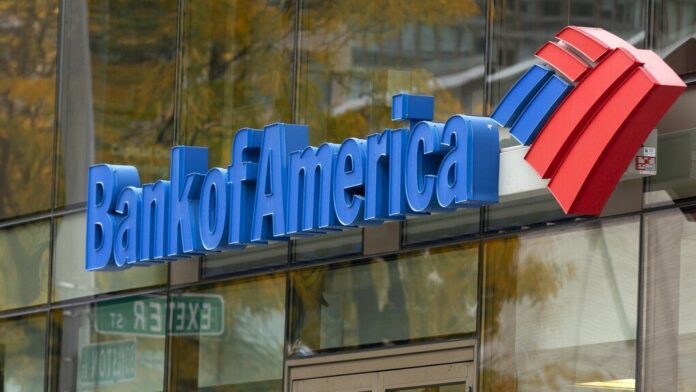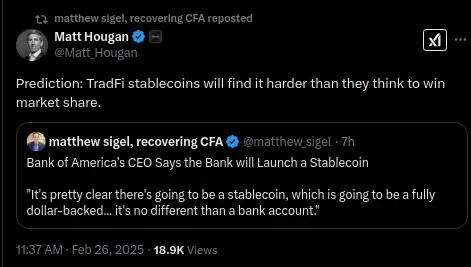
Bank of America CEO Brian Moynihan discussed the bank's plans to launch its own dollar-backed stablecoin and compared the coin to money market funds. Experts like Bitwise's Matt Hougan point out the challenges of competing with current leaders like USDT and USDC.
In a context where cryptocurrencies and blockchain technologies continue to gain ground in the financial world, Bank of America, one of the largest banks in the United States, has expressed its interest in entering the stablecoin market.
During an interview with David Rubenstein at the Economic Club of Washington, Brian Moynihan, CEO of the institution, stressed that the bank is ready to launch a dollar-backed stablecoin if legislation allows it.
TRADE WITH STABLECOINSMoynihan compared these digital currencies to money market funds, due to their stability and backing in fiat assets, although he acknowledged that their underlying technology makes them similar to cryptocurrencies such as Bitcoin. While the bank has so far been cautious in its approach to the crypto world, recent signals from the Donald Trump administration about a more favorable regulatory framework for these digital assets could accelerate its plans.
On the other hand, Matt Hougan, CEO of Bitwise Asset Management, noted that although the stablecoin market is growing rapidly, new players in the TradFi world, such as Bank of America, could face stiff competition for dominance from USDT and USDC, the main stablecoins today.
Bank of America's stablecoin plans
The stablecoin that Bank of America plans to launch would be a digital currency backed by the US dollar, which would ensure its stability compared to more volatile cryptocurrencies such as Bitcoin or Ethereum. According to Fortune, Moynihan explained that this digital currency would not be radically different from traditional financial products. In fact, during the interview, highlighted that the stablecoin he plans to launch It will be similar to a money market fund with checking access, or a bank account., but operated through blockchain technology.
According to Moynihan, this combination of financial stability and technological innovation could attract both institutional users and individuals looking to take advantage of the benefits of cryptocurrencies without being exposed to their volatility.
PREPARE YOUR WALLETThe issuance of a stablecoin with these characteristics would allow international transactions to be carried out more efficiently and safely, eliminating the problems associated with the physical handling of money.
With its expertise in digital technology, Bank of America could position itself as a key player in this space, especially if US legislation allows it.
The challenge of competing with giants like USDT and USDC
Matt Hougan, CEO of Bitwise Asset Management, has noted that while the stablecoin market is constantly growing, New entrants like Bank of America will face tough competitionCurrently, Tether (USDT) and Circle’s USD Coin (USDC) dominate the market, with a combined market cap of nearly $200.000 billion.
Through a post on X, Hougan emphasized that stablecoins developed by traditional financial companies could have a “more difficult path than expected” to gain market shareHis statements suggest that investors are probably already quite comfortable with USDT and USDC, and will only change their preferences if they see significant added value.

However, it is also true that Bank of America could leverage its reputation as a solid and reliable financial institution to attract large companies and governments. Its expertise in international payments and digital services could also be a key factor in differentiating itself from its competitors.
INVITE AND WINThe regulatory impact on the future of stablecoins
Bank of America’s launch of a stablecoin is crucially dependent on the passage of legislation in the United States. Over the past few years, regulators have debated how to harness the benefits of stablecoins while mitigating the risks associated with this type of digital asset.
Moynihan noted that current legislation is in the process of being clarified, especially under the Trump administration, which has shown a more favorable approach towards cryptocurrencies. Therefore, as we have informed In this regard, the bank is awaiting the approval of more open and favorable legislation to operate freely in this space.
Moreover, technological advances and institutional adoption are putting pressure on regulators to define a clearer legal framework. If this happens, the stablecoin market could expand significantly, becoming a fundamental pillar for digital payments and international transactions.
A strategic step for Bank of America
While Bank of America has been more cautious than other banks, such as JPMorgan, about its involvement in the crypto world, this move reflects its long-term strategy to adapt to technological changes.
Moynihan mentioned that most transactions are already digital, and that the adoption of blockchain technologies could speed up this process. With a dollar-backed stablecoin, the bank could not only retain its current customers, but also attract new users looking to combine financial security with technological innovation.
LINK CARD AND EARNBank of America’s announcement of its interest in launching a dollar-backed stablecoin thus reflects a significant shift in the perception of cryptocurrencies by traditional financial institutions. While the path to adoption would not be without challenges, especially in the face of competitors such as USDT and USDC, the experience and backing of a bank of Bank of America’s stature could make a difference.
The passage of US legislation favourable to digital asset innovation will be key to making this project a reality, but what is clear is that stablecoins are set to play an increasingly important role in the global financial system.
Investing in cryptoassets is not fully regulated, may not be suitable for retail investors due to high volatility and there is a risk of losing all invested amounts.



